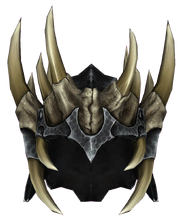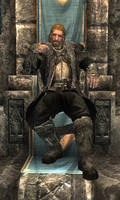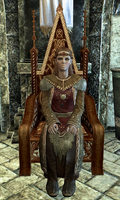- "The High King is ruler above all, and is always one of the Jarls, selected by a body called the "Moot" - a specially convened council of all the Jarls, who meet with the express purpose of choosing Skyrim's High King."
- ―Skyrim's Rule[src]
The High King or High Queen is the leader of Skyrim. Governing the province, those holding this office become a member of the Elder Council of the Empire of Tamriel. Originally, the High King was based in Windhelm, as it was the first capital city established by Ysgramor in the late Merethic Era. The Capital had also shifted to Winterhold sometime in the First Era, but as of the Fourth Era, the High King reigns from Solitude.
Ascension
The High King or Queen typically inherits the throne by birth and rules for life or until abdication.[citation needed] In the event that no direct heir to the throne exists, High Kings are selected by a moot, or vote, conducted by the current Jarls of each of the nine Holds.[1] Votes occur most commonly when the previous High King dies, but an emergency vote can be called to order if the High King is bested in a duel. A High King cannot refuse a duel requested by a Jarl.[2] Without the challenger being allowed to call a new Moot to meet.[3]
The High King swears fealty to the Emperor, and as such Solitude is the city most directly influenced by Imperial culture and politics; thus the Jarl of Solitude has served as High King for generations. According to some source the Moot is, therefore, more formality and theater than anything else.[1] Other sources state that the Moot always meets to select a new High King.[4]
History
Second Era
As a result of the Reman Empire's fall in 2E 431, High King Logrolf was assassinated. When King Svartr claimed his daughter Freydis was illegitimate, a partial moot in Windhelm convened Freydis was queen, while a partial moot in Solitude convened Svartr was king. As a result, the province was split into the West and East kingdoms, ruled separately by each Jarl of the capitals.[5] In 2E 582, Jarl Svargrim ruled the West Kingdom while Jorunn the Skald-King ruled the East Kingdom.[6]
Fourth Era
(right) are the most likely
candidates for High King or Queen
of Skyrim during the Skyrim Civil War.
In the Fourth Era, upon the death of High King Torygg, the Jarls could not agree on the next High King. Torygg's widow, Elisif the Fair, Jarl of Solitude, had a legitimate claim to the throne,[7] although according to Ulfric, ancient Nord tradition dictates that when the High King is bested in battle, the winner can call a Moot to have a new High King chosen.[7] Ulfric Stormcloak, Jarl of Windhelm, believed this gave him a stronger claim to the throne.[7] This resulted in Civil War because the Empire considered the duel unfair and an act of murder, due to Ulfric's use of the Thu'um.[8] It is strongly implied that Ulfric initiated the challenge, plotting to intimidate the other Jarls into naming him High King,[2][7] though Ulfric and his supporters maintained it was a lawful challenge to prove Torygg's weakness as a leader and Skyrim's wretched condition.[7][9] However, if the city of Solitude is taken by the Stormcloaks and the war resolved in their favor, Ulfric rescinds his earlier statement, saying he supports the decision of the Moot, whether he is crowned King or not.[7]
Previous rulers
Listed below are the previous High Kings and Queens of Skyrim followed by their respective reigns:
- Harald – (1E 143 – 1E 221)[10][11]
- Hjalmer – (1E 221 – 1E 222)
- Vrage – (1E 222 – 1E 2?)[12][13]
- Gellir – (1E 2? – 1E ?)[14]
- Borgas – (1E ? – 1E 369)[15]
- Olaf One-Eye – (1E 420 – 1E 452)[10]
- Kjoric the White – (1E 4? – 1E 478)[16]
- Hoag Merkiller – (1E 478 – 1E 480)[16][17]
- Wulfharth – (1E 480 – 1E 533)[10]
- Logrolf – (2E ? – 2E 431)[5]
- Jorunn the Skald-King – (2E 582 – 2E ?)[6]
- Erling – (? – ?)[18]
- Istlod – (4E 150 – 4E 175)[8]
- Torygg – (4E 175 – 4E 201) [19]
City-State Monarchs
Not all kings and queens within the province of Skyrim attain the mantle of High King. While many people outside of Skyrim consider Jarls of the Fourth Era to be pseudo-kings and queens, they are often not royalty. It should be noted that it is possible that Imperial scholars with no real understanding of Nordic society incorrectly labelled these individuals as monarchs when they were in fact Jarls.
The following are individuals who have been recorded as monarchs of individual city states throughout the history of Skyrim:
- Freydis, Queen of Eastern Skyrim – (2E ? – 2E ?)[5][20]
- Svartr, King of Western Skyrim – (2E ? – 2E ?)[5]
- Mabjaarn Flame-Hair, Queen of Eastern Skyrim – (2E ? – 2E 583)[6]
- Jorunn the Skald-King, King of Eastern Skyrim – (2E 583 – 2E ?)[6] Became High King after a Moot.
- Cuhlecain, King of Falkreath – late Second Era (note: Falkreath was considered to be part of Colovia at this time)
- King Mantiarco of Solitude (3E ? – 3E 99)[21]
- Amodetha, Queen of Solitude – Late Third Era[21]
- Potema, Wolf Queen of Solitude – (3E 81 – 3E 137)
- Pelagius Septim III, King of Solitude – (3E 137 – 3E 145)[22][23]
- Jolethe Direnni, Queen of Solitude – (3E 145 – 3E ?)[23]
- King Thian of Solitude – late Third Era[24]
- Queen Macalla of Dawnstar – late Third Era[25]
The Jagged Crown

The Jagged Crown, the Crown Jewel of the High King of Skyrim.
- Main article: The Jagged Crown
The Jagged Crown is the crown of the High King of Skyrim and was used to symbolizes the power over Skyrim. It is made from the teeth and bones of dragons. It is believed to date back to the time of King Harald and is said to contain a portion of the power of every king or queen who wore it since.[26]
The last monarch to wear the crown was King Borgas, but it was believed lost when he was killed in the Wild Hunt of 1E 369. Legend holds that his body was secretly returned to Skyrim and buried with the crown, but the exact whereabouts were lost in the following War of Succession.[26] During the Civil War questline, the Dragonborn can help recover the crown for either the Imperial Legion or the Stormcloaks, providing a great symbolic victory to the side in question.
The Crown of Verity
- Main article: Crown of Verity
The Crown of Verity was an alternative to the Jagged Crown created when the Jagged Crown was lost in the Wild Hunt of 1E 369. It infamously rejected Asurn Ice-Breaker as High King in the fifth century of the First Era, cementing its authority deep into Skyrim's politics.[5]
Other nobility
Trivia
- In ancient and Early Medieval Ireland, the high king (Ard Ri) was a symbolic ruler who professed to have lordship over the whole of Ireland. However, most high king's actual power rarely extended past their native tuatha (tribal kingdom).
- Similarly, in ancient and medieval Germanic Europe (on which Skyrim and the Nords are largely based), authority was usually bestowed upon a high king or emperor, who held the title but had varying levels of authority, depending on the country (in England and Germany, very little; in Scandinavia a fair amount). This system was developed out of ancient Germanic tribal tradition, where their rulers were elected by the freemen of the tribe (and in turn, higher rulers were elected from these representatives of the tribes).
- Hammerfell also has a High King.[27]
Appearances
- The Elder Scrolls Adventures: Redguard
- The Elder Scrolls IV: Oblivion (mentioned only)
- The Elder Scrolls V: Skyrim
- The Elder Scrolls Online
References
- ↑ 1.0 1.1 Skyrim's Rule
- ↑ 2.0 2.1 Dialogue with Elisif the Fair
- ↑ Dialogue with Sybille Stentor
- ↑ Loading Screens (Skyrim)
- ↑ 5.0 5.1 5.2 5.3 5.4 The Crown of Freydis
- ↑ 6.0 6.1 6.2 6.3 Events of The Elder Scrolls Online
- ↑ 7.0 7.1 7.2 7.3 7.4 7.5 Dialogue with Ulfric Stormcloak
- ↑ 8.0 8.1 Dialogue with Sybille Stentor
- ↑ Gerdur's dialogue
- ↑ 10.0 10.1 10.2 Plaque outside of the Palace of the Kings
- ↑ Frontier, Conquest
- ↑ Pocket Guide to the Empire, First Edition: Skyrim
- ↑ King Edward, Book X
- ↑ The Aetherium Wars
- ↑ A History of Daggerfall
- ↑ 16.0 16.1 Rislav the Righteous
- ↑ The Five Songs of Wulfharth
- ↑ Walking the World, Vol XI
- ↑ Nords Arise!
- ↑ Dialogue with Oengul War-Anvil
- ↑ 21.0 21.1 The Wolf Queen, Book II
- ↑ The Wolf Queen, Book VIII
- ↑ 23.0 23.1 The Madness of Pelagius Cite error: Invalid
<ref>tag; name "tmop" defined multiple times with different content - ↑ Pocket Guide to the Empire, Third Edition: Skyrim
- ↑ Pocket Guide to the Empire, Third Edition: Skyrim
- ↑ 26.0 26.1 Dialogue with Galmar Stone-Fist
- ↑ Intro of The Elder Scrolls Adventures: Redguard


